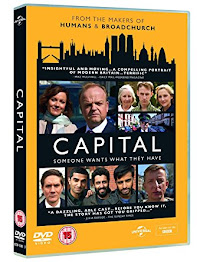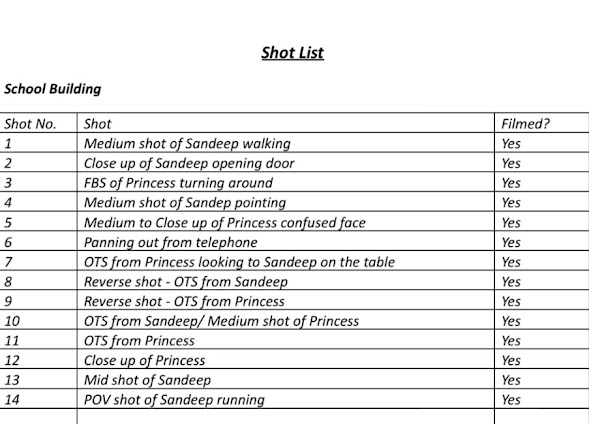Capital: Case study
Work through the following tasks to build a detailed case study for Capital. This will give you plenty of background information to use in an exam question. Remember, for this CSP the question could be on any of the key concepts: language, industries, audiences or representations.
Reviews and features
Read the following review and feature on Capital:
Guardian review by Sam Wollaston
London Evening Standard: five things you need to know about Capital
1) What positive points does the review pick out about Capital? What criticisms are made - either of the TV drama or the original novel?
2) What references can you find in the reviews and feature to the idea Capital is a 'state-of-the-nation' drama? How does it capture modern-day London?
Trailer analysis
Watch the trailer for Capital:
1) How does the drama use camerawork to capture London life?
The trailer uses many camerawork aspects to show the essence of London life. Wide shots showcase the bustling cityscape, highlighting both affluent neighborhoods and more modest areas, illustrating the city's economic diversity. Close-up shots of residents' faces convey personal stories and emotions, emphasizing the human aspect within the urban environment.
2) How does the trailer introduce the different narrative strands suggesting tension or enigma in the 40-second running time?
Within its 40-second runtime, the trailer introduces multiple narrative threads by presenting brief glimpses into the lives of various characters—a wealthy banker, a long-time elderly resident, and a hardworking immigrant. The recurring motif of mysterious postcards with the message "We want what you have" is an enigma code, creating tension and prompting questions about their origin and intent.
The factsheet introduces the diverse cast of Capital, reflecting modern London’s mix of social classes, backgrounds, and experiences. Each character represents different aspects of contemporary British life. There’s a wealthy banker and his family, an elderly woman who’s lived on the same street for decades, an immigrant shopkeeper, and a refugee seeking asylum. These characters bring together themes of wealth, inequality, immigration, and gentrification in the city.
Since Capital was produced for the BBC, it plays a key role in fulfilling the broadcaster’s public service remit. The BBC is supposed to represent different communities and tell stories that reflect British society, and Capital does that. It’s a socially conscious drama that highlights real-world issues like economic disparity and immigration, offering a portrayal of life in London. The show also serves an educational purpose by encouraging discussion on these themes, which aligns with the BBC’s goal of informing and educating audiences.
Kudos is the independent production company behind Capital, but it isn’t entirely “independent” in the traditional sense. It’s owned by a larger media conglomerate which is one of the biggest content producers in the world. Kudos has gone through a few ownership changes over the years, showing how even smaller, critically acclaimed companies get absorbed into bigger global industries.
David Hesmondhalgh argues that the cultural industries, like TV and film, are increasingly shaped by large corporations looking for profit. However, he also points out that creativity still thrives within this structure. Kudos is a great example of this because, even though it’s owned by Banijay, it continues to produce high-quality, thought-provoking dramas like Capital. This suggests that independent creativity can still exist within big media empires, though it’s always influenced by commercial pressures.

The factsheet highlights how Capital blends crime drama with social realism. The show’s crime element comes from the mysterious postcards sent to residents, creating a sense of tension and unease. But the real focus is on everyday life, gentrification, and financial struggles, which makes it a strong example of social realism. The use of handheld cameras and dialogue adds to the sense of realism, making the drama feel authentic.
6) How does the factsheet analyse the DVD packaging and what this communicates to the audience?
The DVD cover of Capital is carefully designed to appeal to its audience. The factsheet points out how the imagery, colors, and fonts suggest both mystery (hinting at the crime element) and a serious social commentary (suggesting the realism aspect). The tagline and artwork reinforce the themes of class tension and inequality.
One audience theory mentioned in the factsheet is the Uses and Gratifications Theory, which can be directly applied to Capital. This theory suggests that audiences actively choose media based on what they want to get out of it. Capital caters to different audience needs:
- Personal identity – Viewers might relate to the struggles of different characters, whether it’s financial difficulties, immigration challenges, or generational differences.
- Surveillance (information-seeking) – The show gives insight into real social issues like gentrification and asylum-seeking, helping audiences understand these topics better.
- Entertainment – The mystery element keeps viewers engaged, even while the show delivers deeper social messages.
1) Write an analysis of the representations in each of the key scenes from episode 1 we studied in the lesson:
Scene 1: Opening Sequence (00:30 – 4:49)
- London as a diverse city – The opening introduces the street and its different residents, showing a mix of ethnicities and social classes.
- Wealth and inequality – The luxurious lifestyle of richer characters is contrasted with those struggling to get by.
Scene 2: Work in the City (6:28 – 8:10)
- Capitalism – Roger, the banker, is shown making huge amounts of money but still feeling unsatisfied, highlighting the issues due to finance
Scene 3: “Which of those isn’t absolutely essential?” (14:00 – 15:35)
- Class differences – Roger and his wife argue about what they “need” in their privileged life, reinforcing how disconnected they are from financial struggle.
Scene 4: Asylum (18:03 – 19:42 & 31:10 – 32:40)
- Immigration and asylum-seeking – The show highlights the fear and uncertainty faced by asylum seekers, challenging negative stereotypes.
Scene 5: “What use is 30 grand?” (36:40 – 39:00)
- Wealth disparity – Roger dismisses a £30,000 bonus as nothing, while many others in the show struggle to afford basic necessities.
Scene 6: Life at the Corner Shop (40:10 – 42:55)
- Hard-working immigrants – The shopkeeper’s daily struggles emphasize the reality of small business owners trying to survive in an expensive city.
2) How does Capital use stereotypes? Do the characters and issues represented in Capital reinforce or subvert the stereotypes we typically see in the media?
How Capital Reinforces Stereotypes:
- The Wealthy Banker: He fits the stereotype of the greedy financier. His dissatisfaction despite a high salary and his wife’s complaints reinforces the idea that the upper class is never satisfied, highlighting themes of financial greed and privilege.
- The Asylum Seeker (Quentina) → She is shown as vulnerable, desperate, and entirely at the mercy of the UK’s immigration system. While her situation is realistic, it aligns with the typical media portrayal of asylum seekers as victims.
- The Police Investigation → The police are depicted as somewhat ineffective and suspicious of certain residents, which ties into common crime drama
How Capital Subverts Stereotypes:
- The Immigrant Shopkeeper (Ahmed) → While many media portrayals of immigrant shopkeepers reduce them to background characters, Ahmed is given a detailed personal life. His struggles, ambitions, and family tensions are explored, showing him as more than just a “hard-working immigrant” stereotype.
- The Older Resident (Petunia) → Elderly characters in media are often portrayed as frail or disconnected from modern life, but Petunia is sharp and independent. Her role highlights the impact of gentrification on long-term residents, giving her story emotional depth.
- Roger’s Wife (Arabella) → Initially appearing as a stereotypical wealthy, materialistic woman, Arabella’s character also reveals layers of insecurity and pressure, suggesting that privilege does not guarantee happiness.
Capital was produced by independent production company Kudos for the BBC. Look at the Kudos website and also read the Kudos Wikipedia page.
1) Who is the parent company for Kudos? What changes of ownership have there been for Kudos? This is an example of conglomerate ownership.
2) Watch the showreel on the Kudos website. What other TV dramas have Kudos produced and for which channels? What awards have they won?
- Spooks (BBC One) – A critically acclaimed spy drama.
- Life on Mars (BBC One) – A time-travel detective series.
- Humans (Channel 4/AMC) – A sci-fi drama exploring AI and human relationships.
- Broadchurch (ITV) – A gripping crime drama that won multiple BAFTAs.
Their work has won BAFTAs, RTS Awards, and International Emmys, proving their ability to create compelling, high-quality content.
The BBC’s public service remit means it has to inform, educate, and entertain while reflecting the diversity of the UK. Capital fits into this perfectly because:
- It represents contemporary Britain – The show explores a multicultural London street, dealing with issues like gentrification, immigration, and economic inequality.
- It tackles social issues – The series encourages viewers to think about class divides, financial struggles, and the impact of wealth.
- It’s accessible to a wide audience – Unlike Hollywood dramas, Capital tells grounded, relatable stories that appeal to BBC’s diverse viewership

Comments
Post a Comment